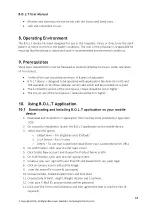
B.O.L.T User Manual
15
© Copyright 2019, All Rights Reserved. AmZetta Technologies Private Ltd.
Do not expose the thermometer to the temperature extremes below 14 °F or over
131 °F (- 10 / 55 °C) or excessive humidity (> 85 % RH non-condensing).
Nail polish or false fingernails may cause inaccurate SpO2 readings.
SpO2 measurements may be adversely affected in the presence of high ambient light,
physical movement, low perfusion, dysfunctional hemoglobin, presence of certain
dyes, etc.
The device may not work when circulation is reduced. Warm or rub the finger, or re-
position the device.
Pulse Oximeter (SpO2 probe) device has no audible alarms and is intended only for
spot-checking.
Pulse Oximeter (SpO2 probe) is designed to determine the percentage of arterial
oxygen saturation of functional hemoglobin. Factors that may degrade pulse oximeter
performance or affect the accuracy of the measurement include the following:
•
do not apply the pulse oximeter on the same arm as a blood pressure cuff,
arterial catheter or infusion line(s) (IVs)
•
excessive light, such as sunlight or direct home lighting
•
excessive motion
•
moisture in the device
•
improperly applied device
•
finger is outside recommended size range
•
poor pulse quality
•
venous pulsations
•
anemia or low hemoglobin concentrations
•
cardio-green and other intravascular dyes
•
carboxyhemoglobin
•
methemoglobin
•
dysfunctional hemoglobin
•
artificial nails or fingernail polish
•
residue (e.g., dried blood, dirt, grease, oil) in the light path
Using the tablet/mobile phone in high ambient light conditions may affect the ability
to read the values correctly.
Use only manufacturer-specified batteries and charging devices.
Do not sterilize, autoclave, or immerse this device in liquid. Do not pour or spray any
liquids into the device.
Portable and mobile RF communications equipment including CT, diathermy, RFID,
and electronic article security systems can affect medical electrical equipment.
This equipment complies with IEC 60601-1-2 for electromagnetic compatibility for
medical electrical equipment and/or systems. This standard is designed to provide
reasonable protection against harmful interference in a typical medical installation.
However, because of the proliferation of radio-frequency transmitting equipment and
other sources of electrical noise in health care and other environments, it is possible
that high levels of such interference due to close proximity or strength of a source
might disrupt the performance of this device. Medical electrical equipment needs















































